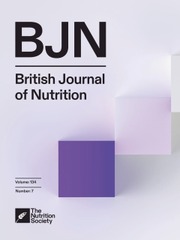Article contents
Non-milk extrinsic sugars in the diets of pre-school children: association with intakes of micronutrients, energy, fat and NSP
Published online by Cambridge University Press: 09 March 2007
Abstract
Concern has been expressed that high dietary concentrations of non-milk extrinsic sugars (NMES) may potentially compromise nutrient intakes in population groups with low energy intakes (Department of Health, 1991). The objective of the present study was to examine data from the National Diet and Nutrition Survey of Children Aged 1.5 to 4.5 years (Gregory et al. 1995) for evidence of an inverse association between energy from NMES and micronutrient intakes, and if possible to quantify a level of NMES-energy at which micronutrient intakes may, theoretically, be compromised. Energy and nutrient intakes were compared across quintiles of NMES-energy for boys (n 848) and girls (n 827). As the concentration of NMES increased, energy intake rose (in boys only) while percentage energy from fat fell from 40 to 32 % across quintiles 1 to 5. Intakes of most micronutrients also fell, while intakes of vitamin C rose. Mean intakes of most micronutrients (Ca, thiamin, riboflavin, niacin, folate and vitamin C) were adequate in comparison with dietary reference values. However, intakes of Fe, Zn and vitamin D were low at all levels of NMES-energy and fell below the estimated average requirement for Fe and Zn for NMES concentrations exceeding 24 % of energy. Lower intakes of milk, meat, bread and vegetables, and higher intakes of fruit juice largely explain the observed trends in micronutrient intake. It is concluded that the inverse association of NMES with micronutrient intakes is of most significance for the 20 % of children with diets highest in NMES. However, further work is required to establish whether the associations observed have biological significance with regard to micronutrient status.
- Type
- Human and Clinical Nutrition
- Information
- Copyright
- Copyright © The Nutrition Society 1997
References
REFERENCES
- 52
- Cited by


